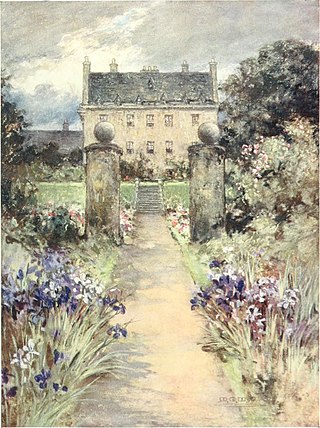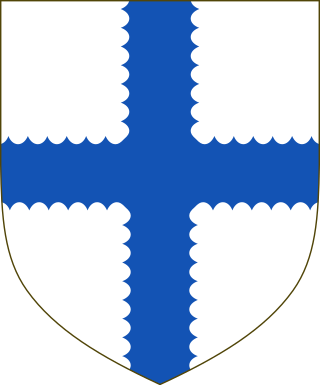Elizabeth Sinclair was a servant of Margaret Tudor (1489-1541), the wife of James IV of Scotland.
Contents

Elizabeth Sinclair was a servant of Margaret Tudor (1489-1541), the wife of James IV of Scotland.

She was either a daughter of William Sinclair, 3rd Lord Sinclair (died 1487) and Christian Leslie, or a daughter of Henry Sinclair, 4th Lord Sinclair (died 1513) and Margaret Hepburn. The royal treasurer's accounts describe her as Lord Sinclair's daughter. [1]
Gift giving on New Year's Day was highly ritualised. [2] Elizabeth Sinclair was at court on New Year's Day 1512 at Linlithgow Palace, and was given a gift of a gold chain worth £7-4s Scots, Christian Ray's gift was worth £7, Ellen More received £3-10s. In January 1513 Sinclair got 10 French gold crowns, and Ellen and Margaret More had ten gold crowns between them. Eight ladies of the Queen's bedchamber (presumably including Sinclair) were given gold rings, made by John Aitkin in his workshop at Stirling Castle. [3]
In February 1512 Elizabeth Sinclair, was given as a reward for her services to the king and queen the right to marry Walter Drummond (died 1518), the heir of John, Lord Drummond, or to sell this right to another. Walter Drummond married Elizabeth Graham, a daughter of William Graham, 1st Earl of Montrose in 1513 and Sinclair may have gained the "profit" of his marriage. [4]
Margaret Tudor gained control of her son James V (1512-1542) and was Regent of Scotland in the summer of 1524. She was able to grant offices and reward her followers. [5] On 29 August 1524 Margaret Tudor rewarded Sinclair for her service with the income from farms in her dower lands at Cessintully near Thornhill, including a property called McCorolstoun. [6] Sinclair also received an income from a part of the queen's lands at Cornton. Christian Ray had a liferent income from the Newtown of Doune. All these lands are in Stirlingshire. [7]
By 1540, Elizabeth Sinclair was married to Bartholomew or Bartilmo Balfour. [8] Women in early modern Scotland did not use their husband's surnames after marriage. [9] [10] Bartholomew Balfour had been appointed as a squire and gentleman in the household of James V in 1524. [11]
Bartholomew Balfour participated in a feud concerning the Queen's lands in Menteith in 1529. He sided with James Stewart, Captain of Doune Castle against William Edmonstone of Duntreath. In a court case, Henry Stewart, 1st Lord Methven, brother of the Captain of Doune, a member of the king's household since 1524, and now married to Margaret Tudor, spoke on behalf of Balfour. [12]
Their son was probably Bartholmew Balfour (died 1547), who was killed at the battle of Pinkie. Called the "Laird of MacKarestowne" in Menteith, after the property gifted to his mother, he married Margaret Drummond, a daughter of Alexander Drummond of Carnock. [13] Their children included Henry and Bartholomew Balfour, commanders of Scots troops in the Netherlands. [14]

Margaret Tudor was Queen of Scotland from 1503 until 1513 by marriage to King James IV. She then served as regent of Scotland during her son's minority, and successfully fought to extend her regency. Margaret was the eldest daughter and second child of King Henry VII of England and Elizabeth of York, and the elder sister of King Henry VIII of England.
Janet Kennedy, was a Scottish noble and the mistress of King James IV of Scotland.
Sir Alexander Lauder of Blyth, Knt. was Provost of Edinburgh almost continually from 1500 to 1513. He was Commissioner to the Scottish Parliament, 1504–06, and an Auditor of the Exchequer in Scotland. He appears to have been on terms of intimacy with the King, James IV, with whom he played cards and to whom he occasionally lent money. "He led the men of Edinburgh to join the King's host" at the battle of Flodden, and fell there.

Alexander Elphinstone, 1st Lord Elphinstone was a Scottish peer. He was the son of Sir John Elphinstone of that ilk and of Pittendreich.
Robert Maxwell, 5th Lord Maxwell was a member of the Council of Regency (1536) of the Kingdom of Scotland, Regent of the Isle of Arran and like his father before him patriarch of the House of Maxwell/Clan Maxwell. A distinguished Scottish nobleman, politician, soldier and in 1513 Lord High Admiral, Lord Maxwell was a member of James V of Scotland's royal council and served as Lord Provost of Edinburgh in 1524, 1527 and 1535. He was also an Extraordinary Lord of Session in 1533. In 1537, he was one of the ambassadors sent to the French Court to negotiate the marriage of James to Mary of Guise, whom he espoused as proxy for the King.
Katherine Bellenden was a courtier working in the wardrobe of James V of Scotland. Her niece of the same name was similarly employed.
Andrew Stewart, 2nd Lord Avondale or Andrew Stuart, 1st Lord Ochiltree, was a Scottish peer.

"Of Ane Blak-Moir" is a short poem in Scots by William Dunbar.

Margaret Stewart, Lady Gordon was the daughter of James IV of Scotland and his mistress Margaret Drummond.

Alexander Drummond of Carnock, was a Scottish landowner and ally of the Douglas family involved in a plan to besiege Stirling Castle.
James Stewart, 1st Lord Doune (1529-1590) was a Scottish landowner.

Robert Gibb or Gib (1490-1558) was a Scottish landowner and courtier.
James Hommyll, was a wealthy merchant in Edinburgh.

John Mosman was an apothecary at the Scottish court.
Elizabeth Barlay or Barlow was an English lady in waiting to Margaret Tudor the wife of James IV of Scotland.

Robert Spittell or Spittall or Spittale was a Scottish tailor who served Margaret Tudor, queen consort of James IV of Scotland.

Henry Sinclair was a Scottish noble and the 4th Lord Sinclair. In The Scots Peerage by James Balfour Paul he is designated as the 3rd Lord Sinclair, but historian Roland Saint-Clair designates him the 4th Lord Sinclair and references this to an Act of the Scottish Parliament in which he was made Lord Sinclair based on his descent from his great-grandfather, Henry II Sinclair, Earl of Orkney, the first Lord Sinclair. Bernard Burke, in his a Genealogical and Heraldic Dictionary of the Peerage and Baronetage of the British Empire, agrees with Roland Saint-Clair and says that Henry Sinclair was "in reality" the fourth holder of the title of Lord Sinclair.

William Sutherland, 5th of Duffus was a member of the Scottish nobility and a cadet of the Clan Sutherland.

Margaret Dennet was an English servant of Margaret Tudor, the wife of James IV of Scotland, and the owner of lands near Inverness.
Archibald Edmondstone of Duntreath was a Scottish landowner and courtier.